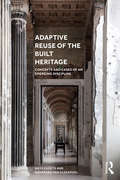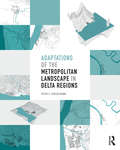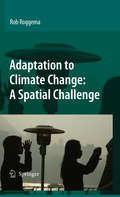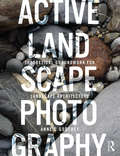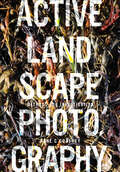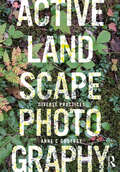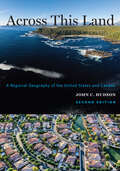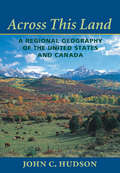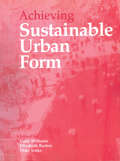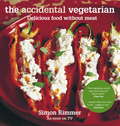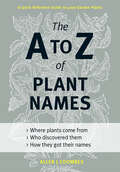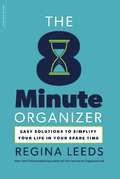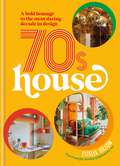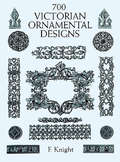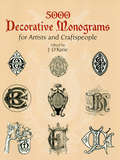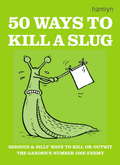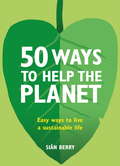- Table View
- List View
Adaptive Reuse of the Built Heritage: Concepts and Cases of an Emerging Discipline
by Bie Plevoets Koenraad Van CleempoelAdaptive reuse – the process of repairing and restoring existing buildings for new or continued use – is becoming an essential part of architectural practice. As mounting demographic, economic, and ecological challenges limit opportunities for new construction, architects increasingly focus on transforming and adapting existing buildings. This book introduces adaptive reuse as a new discipline. It provides students and professionals with the understanding and the tools they need to develop innovative and creative approaches, helping them to rethink and redesign existing buildings – a skill which is becoming more and more important. Part I outlines the history of adaptive reuse and explains the concepts and methods that lie behind new design processes and contemporary practice. Part II consists of a wide range of case studies, representing different time periods and strategies for intervention. Iconic adaptive reuse projects such as the Caixa Forum in Madrid and the Rijksmuseum in Amsterdam are discussed alongside less famous and spontaneous transformations such as the Kunsthaus Tacheles in Berlin, in addition to projects from Italy, Spain, Croatia, Belgium, Poland, and the USA. Featuring over 100 high-quality color illustrations, Adaptive Reuse of the Built Heritage is essential reading for students and professionals in architecture, interior design, heritage conservation, and urban planning.
Adaptations of the Metropolitan Landscape in Delta Regions
by Peter C BosselmannAdaptations of the Metropolitan Landscape in Delta Regions is about environmental quality and the long term livability of urban areas. In decades to come, climate change will affect cities everywhere, but nowhere have the effects of climate change already been felt as strongly as in low-lying coastal cities, cities located in large river deltas and near tidal estuaries. This book reflects on the contribution that spatial planning and urban design can make to a complex discussion about how city form and landscapes will need to adapt within metropolitan areas. The book’s focus is on the urban form of three delta regions: the Pearl River Delta in Southern China; the Rhine, Maas, and Scheldt Delta in the Netherlands; and the San Francisco Bay Area in Northern California. The three regions differ greatly, but despite their different political systems, history, culture and locations in three different climate zones, all three regions will be forced to respond to similar issues that will trigger transformations and adaptations to their urban form. Richly illustrated in color with detailed diagrams, models, photographs and sketches, the book is written for students, scholars and practitioners of environmental planning, and designers who need to respond to the future form of cities in light of climate change. For the professions shaping the physical world of cities and regions, the challenge is not only one of designing physical geometries but of social consequences.
Adaptations of the Metropolitan Landscape in Delta Regions
by Peter C BosselmannAdaptations of the Metropolitan Landscape in Delta Regions is about environmental quality and the long term livability of urban areas. In decades to come, climate change will affect cities everywhere, but nowhere have the effects of climate change already been felt as strongly as in low-lying coastal cities, cities located in large river deltas and near tidal estuaries. This book reflects on the contribution that spatial planning and urban design can make to a complex discussion about how city form and landscapes will need to adapt within metropolitan areas. The book’s focus is on the urban form of three delta regions: the Pearl River Delta in Southern China; the Rhine, Maas, and Scheldt Delta in the Netherlands; and the San Francisco Bay Area in Northern California. The three regions differ greatly, but despite their different political systems, history, culture and locations in three different climate zones, all three regions will be forced to respond to similar issues that will trigger transformations and adaptations to their urban form. Richly illustrated in color with detailed diagrams, models, photographs and sketches, the book is written for students, scholars and practitioners of environmental planning, and designers who need to respond to the future form of cities in light of climate change. For the professions shaping the physical world of cities and regions, the challenge is not only one of designing physical geometries but of social consequences.
Adaptation to Climate Change: A Spatial Challenge
by Rob RoggemaAs it becomes clear that climate change is not easily within the boundaries of the 1990’s, society needs to be prepared and needs to anticipate future changes due to the uncertain changes in climate. So far, extensive research has been carried out on several issues including the coastal defence or shifting ecozones. However, the role spatial design and planning can play in adapting to climate change has not yet been focused on. This book illuminates the way adaptation to climate change is tackled in water management, ecology, coastal defence, the urban environment and energy. The question posed is how each sector can anticipate climate change by creating spatial designs and plans. The main message of this book is that spatial design and planning are a very useful tool in adapting to climate change. It offers an integral view on the issue, it is capable in dealing with uncertainties and it opens the way to creative and anticipative solutions. Dealing with adaptation to climate change requires a shift in mindset; from a technical rational way of thinking towards an integral proactive one. A new era in spatial design and planning looms on the horizon.
Active Landscape Photography: Theoretical Groundwork for Landscape Architecture
by Anne C GodfreyPhotographs play a hugely influential but largely unexamined role in the practice of landscape architecture and design. Through a diverse set of essays and case studies, this seminal text unpacks the complex relationship between landscape architecture and photography. It explores the influence of photographic seeing on the design process by presenting theoretical concepts from photography and cultural theory through the lens of landscape architecture practice to create a rigorous, open discussion. Beautifully illustrated in full color throughout, with over 200 images, subjects covered include the diversity of everyday photographic practices for design decision making, the perception of landscape architecture through photography, transcending the objective and subjective with photography, and deploying multiplicity in photographic representation as a means to better represent the complexity of the discipline. Rather than solving problems and providing tidy solutions to the ubiquitous relationship between photography and landscape architecture, this book aims to invigorate a wider dialogue about photography's influence on how landscapes are understood, valued and designed. Active photographic practices are presented throughout for professionals, academics, students and researchers.
Active Landscape Photography: Theoretical Groundwork for Landscape Architecture
by Anne C GodfreyPhotographs play a hugely influential but largely unexamined role in the practice of landscape architecture and design. Through a diverse set of essays and case studies, this seminal text unpacks the complex relationship between landscape architecture and photography. It explores the influence of photographic seeing on the design process by presenting theoretical concepts from photography and cultural theory through the lens of landscape architecture practice to create a rigorous, open discussion. Beautifully illustrated in full color throughout, with over 200 images, subjects covered include the diversity of everyday photographic practices for design decision making, the perception of landscape architecture through photography, transcending the objective and subjective with photography, and deploying multiplicity in photographic representation as a means to better represent the complexity of the discipline. Rather than solving problems and providing tidy solutions to the ubiquitous relationship between photography and landscape architecture, this book aims to invigorate a wider dialogue about photography's influence on how landscapes are understood, valued and designed. Active photographic practices are presented throughout for professionals, academics, students and researchers.
Active Landscape Photography: Methods for Investigation (Active Landscape Photography)
by Anne C GodfreyHow can photography be transformed into an active process of investigation for landscape architecture and environmental design? The second book in Godfrey’s series, Active Landscape Photography, presents engaged photographic methods that turn photography into a rigorous, thoughtful endeavor for the research, planning and design of landscape places. Photography is the most ubiquitous and important form of representation in these disciplines. Yet photography is not specifically taught as a core skill within these fields. This book creates a starting point for filling this gap. Concepts and working methods from contemporary photography and critical cultural theories are contextualized into situations encountered in the daily practice of landscape architecture and environmental design. These methods can be integrated into practices in academic and professional settings or picked up and self-taught by an individual reader. Part I: Methods presents easily accessible approaches to photography creating a core set of active skills. Part II: Practices discusses working methods of specific contemporary photographers and extrapolates their practices into common extrapolates their practices into common planning and design situations. Contemporary photographers presented include Richard Misrach, Dawoud Bey, Duane Michals, Latoya Ruby Frazier, Mark Klett, Sophie Calle, Joe Deal, Robert Adams, Naima Green, Bernd and Hilla Becher, Stephen Shore, David Hockney, Amy Sherald, William Christenberry, Jeff Wall, and Sohei Nishino. Beautifully illustrated in full color with over 150 images by Godfrey, her students, and contemporary photographers, this book provides both clear guidelines for a set of diverse methods as well as a deeper discussion about the implications of making and using photography in environmental design for professionals, academics, students and researchers.
Active Landscape Photography: Methods for Investigation (Active Landscape Photography)
by Anne C GodfreyHow can photography be transformed into an active process of investigation for landscape architecture and environmental design? The second book in Godfrey’s series, Active Landscape Photography, presents engaged photographic methods that turn photography into a rigorous, thoughtful endeavor for the research, planning and design of landscape places. Photography is the most ubiquitous and important form of representation in these disciplines. Yet photography is not specifically taught as a core skill within these fields. This book creates a starting point for filling this gap. Concepts and working methods from contemporary photography and critical cultural theories are contextualized into situations encountered in the daily practice of landscape architecture and environmental design. These methods can be integrated into practices in academic and professional settings or picked up and self-taught by an individual reader. Part I: Methods presents easily accessible approaches to photography creating a core set of active skills. Part II: Practices discusses working methods of specific contemporary photographers and extrapolates their practices into common extrapolates their practices into common planning and design situations. Contemporary photographers presented include Richard Misrach, Dawoud Bey, Duane Michals, Latoya Ruby Frazier, Mark Klett, Sophie Calle, Joe Deal, Robert Adams, Naima Green, Bernd and Hilla Becher, Stephen Shore, David Hockney, Amy Sherald, William Christenberry, Jeff Wall, and Sohei Nishino. Beautifully illustrated in full color with over 150 images by Godfrey, her students, and contemporary photographers, this book provides both clear guidelines for a set of diverse methods as well as a deeper discussion about the implications of making and using photography in environmental design for professionals, academics, students and researchers.
Active Landscape Photography: Diverse Practices (Active Landscape Photography)
by Anne C GodfreyDiverse Practices, the third book in the Active Landscape Photography series, presents a set of unique photographic examples for site-specific investigations of landscape places. Contributed by authors across academia, practice and photography, each chapter serves as a rigorous discussion about photographic methods for the landscape and their underlying concepts. Chapters also serve as unique case studies about specific projects, places and landscape issues. Project sites include the Miller Garden, Olana, XX Miller Prize and the Philando Castile Peace Garden. Landscape places discussed include the archeological landscapes of North Peru, watery littoral zones, the remote White Pass in Alaska, Sau Paulo and New York City’s Chinatown. Photographic image-making approaches include the use of lidar, repeat photography, collage, mapping, remote image capture, portraiture, image mining of internet sources, visual impact assessment, cameraless photography, transect walking and interviewing. These diverse practices demonstrate how photography, when utilized through a set of specific critical methods, becomes a rich process for investigating the landscape. Exploring this concept in relationship to specific contemporary sties and landscape issues reveals the intricacy and subtlety that exists when photography is used actively. Practitioners, academics, students and researchers will be inspired by the underlying concepts of these examples and come away with a better understanding about how to create their own rigorous photographic practices.
Active Landscape Photography: Diverse Practices (Active Landscape Photography)
Diverse Practices, the third book in the Active Landscape Photography series, presents a set of unique photographic examples for site-specific investigations of landscape places. Contributed by authors across academia, practice and photography, each chapter serves as a rigorous discussion about photographic methods for the landscape and their underlying concepts. Chapters also serve as unique case studies about specific projects, places and landscape issues. Project sites include the Miller Garden, Olana, XX Miller Prize and the Philando Castile Peace Garden. Landscape places discussed include the archeological landscapes of North Peru, watery littoral zones, the remote White Pass in Alaska, Sau Paulo and New York City’s Chinatown. Photographic image-making approaches include the use of lidar, repeat photography, collage, mapping, remote image capture, portraiture, image mining of internet sources, visual impact assessment, cameraless photography, transect walking and interviewing. These diverse practices demonstrate how photography, when utilized through a set of specific critical methods, becomes a rich process for investigating the landscape. Exploring this concept in relationship to specific contemporary sties and landscape issues reveals the intricacy and subtlety that exists when photography is used actively. Practitioners, academics, students and researchers will be inspired by the underlying concepts of these examples and come away with a better understanding about how to create their own rigorous photographic practices.
Across This Land: A Regional Geography of the United States and Canada (Creating the North American Landscape)
by John HudsonBased on decades of research and written in clear, concise prose by one of the foremost geographers in North America, John C. Hudson's Across This Land is a comprehensive regional geography of the North American continent. Dividing the terrain into ten regions, which are then subdivided into twenty-seven smaller areas, Hudson's brisk narrative reveals the dynamic processes of each area's distinctive place-specific characteristics. Focusing on how human activities have shaped and have been shaped by the natural environment, Hudson considers physical, political, and historical geography. He also highlights related topics, including resource exploitation, economic development, and population change. Praised in its first edition as a readable and reliable interpretation of United States and Canadian geography, the revised Across This Land retains these strengths while adding substantial new material. Incorporating the latest available population and economic data, this thoroughly updated edition includes• reflections on new developments, such as resource schemes, Native governments in Atlantic Canada, and the role of climate change in the Arctic• a new section focused on the US Pacific insular territories west of Hawaii• evolving views of oil and gas production resulting from the introduction of hydraulic fracturing• revised text and maps involving agricultural production based on the 2017 Census of Agriculture• current place names• more than 130 photographsThe most extensive regional geography of the North American continent on the market, Hudson's Across This Land will continue as the standard text in geography courses dealing with Canada and the United States, as well as a popular reference work for scholars, students, and lay readers.
Across This Land: A Regional Geography of the United States and Canada (Creating the North American Landscape)
by John HudsonBased on decades of research and written in clear, concise prose by one of the foremost geographers in North America, John C. Hudson's Across This Land is a comprehensive regional geography of the North American continent. Dividing the terrain into ten regions, which are then subdivided into twenty-seven smaller areas, Hudson's brisk narrative reveals the dynamic processes of each area's distinctive place-specific characteristics. Focusing on how human activities have shaped and have been shaped by the natural environment, Hudson considers physical, political, and historical geography. He also highlights related topics, including resource exploitation, economic development, and population change. Praised in its first edition as a readable and reliable interpretation of United States and Canadian geography, the revised Across This Land retains these strengths while adding substantial new material. Incorporating the latest available population and economic data, this thoroughly updated edition includes• reflections on new developments, such as resource schemes, Native governments in Atlantic Canada, and the role of climate change in the Arctic• a new section focused on the US Pacific insular territories west of Hawaii• evolving views of oil and gas production resulting from the introduction of hydraulic fracturing• revised text and maps involving agricultural production based on the 2017 Census of Agriculture• current place names• more than 130 photographsThe most extensive regional geography of the North American continent on the market, Hudson's Across This Land will continue as the standard text in geography courses dealing with Canada and the United States, as well as a popular reference work for scholars, students, and lay readers.
Across This Land: A Regional Geography of the United States and Canada (Creating the North American Landscape)
by John C. HudsonBased on decades of research and written in clear, concise prose by one of the foremost geographers in North America, John C. Hudson's Across This Land is a comprehensive regional geography of the North American continent.Clearly organized, the book divides the entire United States and Canada into six major regions, then further subdivides them into twelve smaller areas. Hudson emphasizes each region or area's distinguishing place-specific attributes, including—to a larger degree than previous regional geographies—political considerations. In this way, the book tells the story of each region, relying on a brisk narrative that reveals the dynamic processes of their distinctive characteristics. The first extensive regional geography of the North American continent in over seventy-five years, Hudson's Across This Land will become the standard text in geography courses dealing with Canada and the U.S. as well as a popular reference work for scholars, students, and lay readers.
Achieving Sustainable Urban Form
by Elizabeth Burton Mike Jenks Katie WilliamsAchieving Sustainable Urban Form represents a major advance in the sustainable development debate. It presents research which defines elements of sustainable urban form - density, size, configuration, detailed design and quality - from macro to micro scale. Case studies from Europe, the USA and Australia are used to illustrate good practice within the fields of planning, urban design and architecture.
Achieving Sustainable Urban Form
by Katie Williams Elizabeth Burton Mike JenksAchieving Sustainable Urban Form represents a major advance in the sustainable development debate. It presents research which defines elements of sustainable urban form - density, size, configuration, detailed design and quality - from macro to micro scale. Case studies from Europe, the USA and Australia are used to illustrate good practice within the fields of planning, urban design and architecture.
The Accidental Vegetarian: Delicious food without meat
by Simon RimmerWhen Simon Rimmer bought a small vegetarian restaurant, he had no idea how to cook. Armed with two cookbooks and heaps of enthusiasm, he and a friend created the best vegetarian restaurant in Manchester, famous for its unusual food and lovely atmosphere. A confirmed meat eater, Simon had to rethink his cooking and has created vegetarian recipes to please even the most dedicated carnivore. This book is a collection of some of his recipes that are quick to prepare but totally delicious. From good old favourites like macaroni cheese to Simon's more exotic fusion creations such as spicy beetroot and coconut soup, The Accidental Vegetarian will kill the lentil and sandal image of vegetarianism forever!
The A to Z of Plant Names: A Quick Reference Guide to 4000 Garden Plants
by Allen J. CoombesBotanical names can be baffling to even the most experienced gardener. But a plant's botanical name is more than just a handy label—it can tell a plant's country of origin, the shape of its leaves, the color of its petals, and much more. The A to Z of Plant Names clears the confusion and allows every gardener to name plants with confidence. This comprehensive yet handy guide features the botanic names of the plants that gardeners really grow. Additional information includes suggested pronunciation, the common name, the derivation of the scientific name, the number of species currently accepted, the type of plant and the distribution. The A to Z of Plant Names helps demystify names, provides readers with the intriguing background information to naming conventions, and empowers gardeners everywhere to feel confident about naming plants.
The 8 Minute Organizer: Easy Solutions to Simplify Your Life in Your Spare Time
by Regina LeedsWhether you are busy dealing with a demanding job, raising kids, or coping with illness, simply finding the time to get organized can be a challenge. The 8-Minute Organizer to the rescue!Regina Leeds shows how anyone can organize their home with just a few minutes each day. She has tailored her magic formula (eliminate, categorize, organize) so that readers can work in short, effective increments and complete small projects that add up to big progress. The book includes hundreds of systems and tricks--from rapid closet rehab to tackling junk drawers, clutter-busting a room to setting up a mail system. Leeds also offers quick but important daily routines (making the bed), periodic tasks (checking the smoke detector), and fun projects (creating a dream board) to keep up the momentum.
The 8 Minute Organizer: Easy Solutions to Simplify Your Life in Your Spare Time
by Regina LeedsWhether you are busy dealing with a demanding job, raising kids, or coping with illness, simply finding the time to get organized can be a challenge. The 8-Minute Organizer to the rescue!Regina Leeds shows how anyone can organize their home with just a few minutes each day. She has tailored her magic formula (eliminate, categorize, organize) so that readers can work in short, effective increments and complete small projects that add up to big progress. The book includes hundreds of systems and tricks--from rapid closet rehab to tackling junk drawers, clutter-busting a room to setting up a mail system. Leeds also offers quick but important daily routines (making the bed), periodic tasks (checking the smoke detector), and fun projects (creating a dream board) to keep up the momentum.
70s House: A bold homage to the most daring decade in design
by Estelle Bilson"I loved the 70s - and that's both the 1970s and the 1870s. There's obviously always something about a decade that starts with a seven that means the design dial is turned to 11; colours get bolder, shapes get badder and style flies its freak flag. So, thank goodness resplendent 70s temptress Estelle Bilson has committed pen to paper so that the world can enjoy her take on the era of soft squares, teak, shag and Artex." - Laurence Llewelyn-Bowen"[Estelle Bilson] gives people the courage to use [her] products without fear - [she is] brilliant - I think [she] is the most important creative look since Conran." Barbara Hulanicki OBEFrom disco and glam to space age and psychedelic, there's no denying the huge impact the 70s had on style and design. But how do you bring the era's maximalism to your interior without it looking like a cluttered junk shop or a period pastiche?Estelle Bilson aka @70shousemanchester transformed her unremarkable 3-bedroom terraced home into a 70s wonderland, using a thrifty eye and vintage know-how. In her first book, she shows you how to bring the same creative magic to your home with her expert advice, tips and tricks on choosing colour, pattern, shapes and materials - whether you're after a few nods to the era, or the full 70s fantasy.70s House is the definitive guide to the most daring decade in design, covering everything from shag carpets and supergraphics, to Hornsea ceramics and G Plan furniture. The book is split into three sections: 70s influences - what shaped the era?; How to bring the 70s to your interior design; and At home with 70s House Manchester. And of course, it wouldn't be the 70s without a good old-fashioned shindig - Estelle also reveals her secrets to throwing the grooviest get-together, complete with vintage recipes and record selections to match.Part interiors guide, part manual for living, this loud-and-proud book will bring not only 70s colour and kitsch to the modern day, but also the rebellious spirit, pure joy and freewheeling energy epitomised by the era.Because the 70s is so much more than the decade that taste forgot.
700 Victorian Ornamental Designs (Dover Pictorial Archive)
by F. KnightThis lavish collection of royalty-free engravings by the celebrated 19th-century artist F. Knight — reproduced directly from a rare original edition — contains elaborate wall murals with trompe-l’oeil effects; scenes of hunters, flanked by mythological figures; idealized damsels in rustic settings; and numerous other florid motifs.
5000 Designs and Motifs from India
by Ajit MookerjeeIncredibly rich treasury of authentic royalty-free designs adapted from artifacts of the Harappa culture, coins and pottery from South India, Ajanta and Bagh murals, Muslim monuments, Buddhist temples, textiles from Gujarat, Punjab, other regions, masks and tribal arts, much more. Immediately usable material or great resource for design inspiration. Introduction. Notes.
5000 Decorative Monograms for Artists and Craftspeople
by J. O'KaneVoluminous, diversified collection of ornamental two-, three-, and four-letter combinations -- all in a rich variety of styles. Arranged alphabetically in columns, each series is grouped under an appropriate head. Crowns, coronets, and many ancient and modern alphabets are displayed, making this comprehensive sourcebook of permission-free designs indispensable. 130 black-and-white plates.
50 Ways to Kill a Slug: Serious And Silly Ways To Kill Or Outwit The Garden's Number One Enemy
by Sarah FordAre you being bullied by a mollusc that slimes all over your garden and munches through your favourite delphinium? Are you worried about using slug pellets for fear of endangering local wildlife? Take a stand against slugs with 50 alternative, organic, natural, chemical and humane solutions to slug problems. Trick, flick and frighten slugs out of your garden, leaving you with pest-free plants. Stop slugs in their tracks and make slimy trails a thing of the past.
50 Ways to Help the Planet: Easy ways to live a sustainable life
by Sian BerryWe are becoming increasingly aware and engaged in environmental issues, but it's not always clear what the solutions are and how we can do our bit. We are ready and willing to make changes to our lifestyles, but often the advice about which are the best ones to make can be confusing.In this friendly guide you are shown how you can make changes in a positive and practical manner, and with some suggestions easier than others, there's a multitude of ways in which you can live more sustainably. Siân looks at the choices we can all make, helping you to reduce your carbon footprint and the impact of your lifestyle on the planet and change the world without changing your life.The 50 ways are divided into Plastics, Energy, Cooking and Eating, Travel, In the Garden and Action, and include a range of options, such as buying plastic-free beauty products, upcycling your furniture, cutting down on meat and having greener celebrations.
